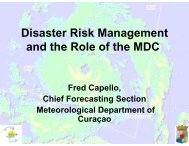The Anatomy of A Silent Crisis The Anatomy of A Silent Crisis
The Anatomy of A Silent Crisis The Anatomy of A Silent Crisis
The Anatomy of A Silent Crisis The Anatomy of A Silent Crisis
- TAGS
- anatomy
- www.bb.undp.org
You also want an ePaper? Increase the reach of your titles
YUMPU automatically turns print PDFs into web optimized ePapers that Google loves.
28 Forum 2009: Climate Change – <strong>The</strong> <strong>Anatomy</strong> <strong>of</strong> a <strong>Silent</strong> <strong>Crisis</strong><br />
Health: Climate change increases the spread <strong>of</strong> diseases globally<br />
Climate change threatens to slow, halt or reverse progress towards reducing the spread <strong>of</strong> diseases<br />
and aggravates already enormous health problems, especially in the poorest parts <strong>of</strong> the world<br />
Current weather conditions heavily impact the health <strong>of</strong> poor people in developing nations90 , and<br />
climate change has a multiplying effect. A changing climate further affects the essential ingredients<br />
<strong>of</strong> maintaining good health: clean air and water, sufficient food and adequate shelter. A warmer and<br />
more variable climate leads to higher levels <strong>of</strong> some air pollutants and increases transmission <strong>of</strong><br />
diseases through unclean water and contaminated food. It compromises agricultural production in<br />
some <strong>of</strong> the least developed countries, and it increases the hazards <strong>of</strong> weather-related disasters.<br />
<strong>The</strong>refore global warming, together with the changes in food and water supplies it causes, can<br />
indirectly spurs increases in such diseases as malnutrition, diarrhoea, cardiovascular and respiratory<br />
diseases, and water borne and insect-transmitted diseases. 91 This is especially worrisome because<br />
a massive number <strong>of</strong> people are already impacted by these diseases — for example upwards <strong>of</strong> 250<br />
million malaria cases are recorded each year and over 900 million people are hungry today. 92<br />
Climate change has contributed to the reappearance <strong>of</strong> Lyme disease in the US and Europe, a<br />
disease once thought extinct in those regions. 91 In areas where malaria is common, particularly warmer<br />
and wetter areas, people are able to build up a certain degree <strong>of</strong> natural resistance. However, as climate<br />
warms, the mosquitoes carrying malaria move into new areas, such as traditionally colder, mountainous<br />
regions where people have less natural resistance leading to even more severe malaria epidemics. 93







